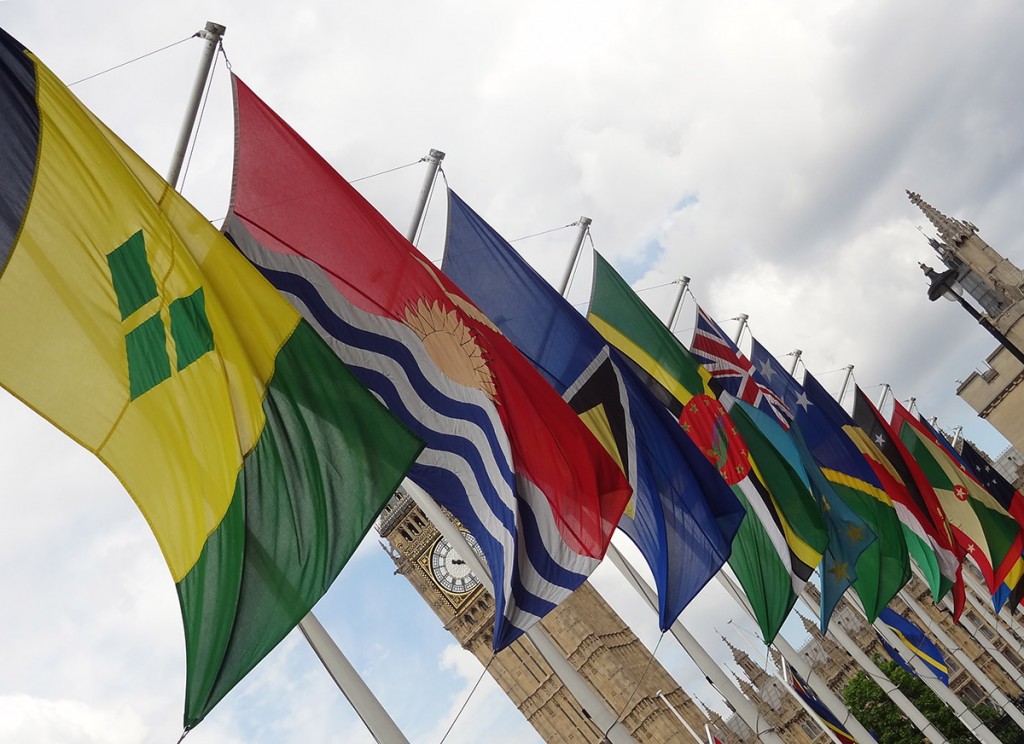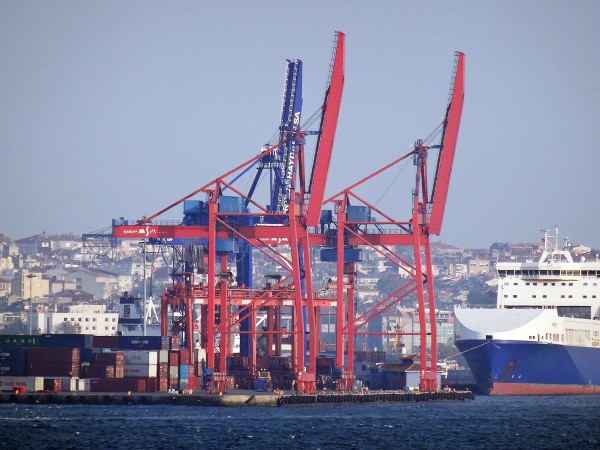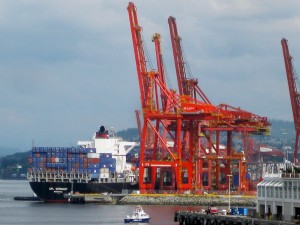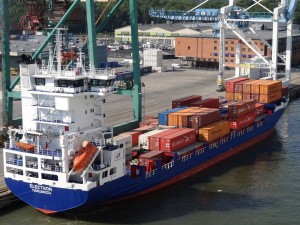 The period from the end of the Second World War until the financial crisis of 2007–8 was one of increasing globalisation. World trade rose considerably faster than world GDP. The average annual growth in world GDP from 1950 to 2007 was 4.2%; the average annual growth in world merchandise exports was 6.7%.
The period from the end of the Second World War until the financial crisis of 2007–8 was one of increasing globalisation. World trade rose considerably faster than world GDP. The average annual growth in world GDP from 1950 to 2007 was 4.2%; the average annual growth in world merchandise exports was 6.7%.
And there were other ways in which the world was becoming increasingly interconnected. Cross-border financial flows grew strongly, especially in the 1990s and up to 2007. In the early 1990s, global cross-border capital flows were around 4% of world annual GDP; by 2007, they had risen to over 20%. The increasing spread of multinational corporations, improvements in transport, greater international movement of labour and improved communications were all factors that contributed to a deepening of globalisation.
 But have things begun to change? Have we entered into an era of ‘deglobalisation’? Certainly some indicators would suggest this. In the three years 2012–14, world exports grew more slowly than world GDP. Global cross-border financial flows remain at about one-third of their 2007 peak. Increased banking regulations are making it harder for financial institutions to engage in international speculative activities.
But have things begun to change? Have we entered into an era of ‘deglobalisation’? Certainly some indicators would suggest this. In the three years 2012–14, world exports grew more slowly than world GDP. Global cross-border financial flows remain at about one-third of their 2007 peak. Increased banking regulations are making it harder for financial institutions to engage in international speculative activities.
What is more, with political turmoil in many countries, multinational corporations are more cautious about investing in such markets. Many countries are seeking to contain immigration. Fears of global instability are encouraging many firms to look inwards. After more than 13 years, settlement of the Doha round of international trade negotiations still seems a long way off. Protectionist measures abound, often amount to giving favourable treatment to domestic firms.
 The Observer article considers whether the process of increased globalisation is now dead. Or will better banking regulations ultimately encourage capital flows to grow again; and will the inexorable march of technological progress give international trade and investment a renewed boost? Will lower energy and commodity prices help to reboot the global economy? Will the ‘Great Recession’ have resulted in what turns out to be merely a blip in the continued integration of the global economy? Is it, as the Huffington Post article states, that ‘globalization has a gravitational pull that is hard to resist’? See what the articles and speech have to say and what they conclude.
The Observer article considers whether the process of increased globalisation is now dead. Or will better banking regulations ultimately encourage capital flows to grow again; and will the inexorable march of technological progress give international trade and investment a renewed boost? Will lower energy and commodity prices help to reboot the global economy? Will the ‘Great Recession’ have resulted in what turns out to be merely a blip in the continued integration of the global economy? Is it, as the Huffington Post article states, that ‘globalization has a gravitational pull that is hard to resist’? See what the articles and speech have to say and what they conclude.
Articles
Borders are closing and banks are in retreat. Is globalisation dead? The Observer, Heather Stewart (23/5/15)
Is Globalization Finally Dead? Huffington Post, Peter Hall (6/5/14)
Speech
Financial “deglobalization”?: capital flows, banks, and the Beatles Bank of England, Kristin Forbes (18/11/14)
Questions
- Define globalisation.
- How does globalisation affect the distribution of income (a) between countries; (b) within countries?
- Why has the Doha round of trade negotiations stalled?
- Examine the factors that might be leading to deglobalisation.
- What are the implications of banking deglobalisation for the UK?
- Are protectionist measures always undesirable in terms of increasing global GDP?
- What forces of globalisation are hard to resist?
 One thing that economists often argue for is free trade. It promotes competition, allows greater choice and generates efficiency gains through specialisation to name a few of the advantages. Barriers to trade have gradually been brought down across the global economy, but some do still exist.
One thing that economists often argue for is free trade. It promotes competition, allows greater choice and generates efficiency gains through specialisation to name a few of the advantages. Barriers to trade have gradually been brought down across the global economy, but some do still exist.
Although free trade does have many advantages, there are also arguments for barriers to trade, especially for developing or emerging economies. In some cases, barriers to trade can help a country to develop a particular industry or offer protection to a new sector from the giants of the world. In the case of China, it had a quota system in place since 2009 to restrict exports of ‘rare earth materials’, such as Tungsten and Molybdenum. Many of the hi-tech products that China specialises in require these rare minerals during production and, as the dominant producer of these minerals, Beijing had imposed restrictions on exporting them in an attempt to develop these industries.
 However, other countries had raised concerns about the quota system being used, suggesting that by restricting exports of rare earth minerals, China was driving up their price. It was also suggested that the restrictions benefited domestic producers, at the expense of foreign competitors, given that domestic producers were able to access the raw materials at cheaper prices.
However, other countries had raised concerns about the quota system being used, suggesting that by restricting exports of rare earth minerals, China was driving up their price. It was also suggested that the restrictions benefited domestic producers, at the expense of foreign competitors, given that domestic producers were able to access the raw materials at cheaper prices.
A complaint was made to the World Trade Organization in March 2014 by the USA, supported by the EU, Canada and Japan. Following an investigation by a WTO panel, the panel found that China had failed to show sufficiently that the quotas were justified. After an appeal by China, the panel’s findings were upheld in August by the WTO.
In response to the failure of its appeal, China has just announced that it is removing the quotas on exports of rare earth materials. However, this is unlikely to be the end of the story, as other policies may well be imposed, including a resources tax; and an export licence is still required. The following articles consider this battle.
China axes rare earth export quotas Financial Times, Lucy Hornby (5/1/15)
China scraps quotas on rare earths after WTO complaint BBC News (5/1/15)
China ends rare-earth minerals export quotas Wall Street Journal, Chuin-Wei Yap (5/1/15)
China scraps rare earth export controls after losing WTO appeal Bloomberg (6/1/15)
China abolishes rare earth export quotas: state media Reuters (4/1/15)
Questions
- What are the benefits of free trade?
- Why do some countries choose to impose protectionist measures and what type of measures can be put in place?
- Using a diagram, explain the impact that export quotas would have on Chinese firms using these rare minerals and also on foreign firms.
- Why have other countries argued that export quotas push up prices of these minerals?
- What other policies might China put in place in order to protect its industries?
 The 159 member countries of the World Trade Organisation have reached an agreement on liberalising trade. The deal, which was reached on 6 December 2013 at a meeting in Bali, is the first substantial agreement since the WTO was formed in 1995 (see Timeline: World Trade Organization for other agreements).
The 159 member countries of the World Trade Organisation have reached an agreement on liberalising trade. The deal, which was reached on 6 December 2013 at a meeting in Bali, is the first substantial agreement since the WTO was formed in 1995 (see Timeline: World Trade Organization for other agreements).
It involves simplifying customs procedures and making them more transparent, limited reductions in tariffs and quotas and allowing greater access to WTO members’ markets for exporters. It also permits developing countries to continue subsidising their agriculture in order to promote food security, provided the practice does not distort international trade. According to the WTO:
The trade facilitation decision is a multilateral deal to simplify customs procedures by reducing costs and improving their speed and efficiency. It will be a legally binding agreement and is one of the biggest reforms of the WTO since its establishment in 1995. …The objectives are: to speed up customs procedures; make trade easier, faster and cheaper; provide clarity, efficiency and transparency; reduce bureaucracy and corruption, and use technological advances. It also has provisions on goods in transit, an issue particularly of interest to landlocked countries seeking to trade through ports in neighbouring countries.
In a report published by the Peterson Institute in Washington, it is estimated that the extra trade will add some $960bn to world GDP and create some 20.6m extra jobs.  But how fully does it meet the objectives of the Doha Development Agenda, the yet-to-be-concluded trade round started in Qatar in November 2001?
But how fully does it meet the objectives of the Doha Development Agenda, the yet-to-be-concluded trade round started in Qatar in November 2001?
According to the EU’s trade commissioner Karel De Gucht, about one quarter of the goals set for the Doha Round have been achieved in this agreement. This, of course, still leaves a long way to go if all the Doha objectives are to be met. World trade, although now likely to be somewhat freer, is still not free; developing countries will still find restricted access for their agricultural products, and manufactures too, to many markets in the rich world; rich countries will still find restricted access for their manufactured products and services to many markets in the developing world.
Articles
A ‘lifeline’ to the world’s poor: Cameron hails WTO historic global trade deal Independent, Kashmira Gander (7/12/13)
Timeline: World Trade Organization BBC News (7/12/13)
WTO Seals Deal for First Time in 18 Years to Ease Trade Bloomberg, Neil Chatterjee, Brian Wingfield & Daniel Pruzin (7/12/13)
WTO agrees global trade deal worth $1tn BBC News, Andrew Walker (7/12/13)
WTO: Government’s tough stand helps clinch deal in its favour Economic Times of India (7/12/13)
India Inc, exporters welcome WTO pact on trade The Hindu, Sandeep Dikshit (7/12/13)
WTO: Pact will help poor Bangkok Post (7/12/13)
WTO overcomes last minute hitch to reach its first global trade deal NDTV Profit (7/12/13)
WTO reaches ‘historic’ trade deal in Bali Aljazeera (7/12/13)
 WTO agrees global trade deal worth $1tn BBC News, Karel De Gucht (7/12/13)
WTO agrees global trade deal worth $1tn BBC News, Karel De Gucht (7/12/13)
Why the WTO agreement in Bali has finally helped developing countries The Guardian, Paige McClanahan (6/12/13)
WTO agreement condemned as deal for corporations, not world’s poor The Guardian, Phillip Inman (7/12/13)
Bali trade agreement: WTO set the bar high but has achieved little The Guardian, Larry Elliott (6/12/13)
Reports and documents
Payoff from the World Trade Agenda, 2013 Peterson Institute for International Economics, Gary Hufbauer and Jeffrey Schott (April 2013)
Days 3, 4 and 5: Round-the-clock consultations produce ‘Bali Package’ WTO (7/12/13)
Draft Bali Ministerial Declaration WTO (see, in particular, Agreement on Trade Facilitation) (7/12/13)
Questions
- According to the law of comparative advantage, there is a net gain from international trade. Explain why.
- What are the likely gains from freer trade?
- Is freer trade necessarily better than less free trade?
- Who is likely to gain most from the WTO deal reached in Bali?
- What were the goals of the Doha Development Agenda?
- In what ways does the Bali agreement fall short of the goals set at Doha in 2001?
- Why is it so difficult to reach a comprehensive international deal on trade liberalisation that also protects the interests of poor countries?
- Do you agree with the World Development Movement (WDM) that the Bali Package is “an agreement for transnational corporations, not the world’s poor”?
- Would it now benefit the world for individual countries to pursue bilateral trade deals?
 International economists have long advocated the advantages of free trade. By boosting competition, increasing choice and market size, trade has long been seen as an engine of growth and efficiency.
International economists have long advocated the advantages of free trade. By boosting competition, increasing choice and market size, trade has long been seen as an engine of growth and efficiency.
For many years, tariffs and other restrictive trade practices have been removed on trade between both developed and developing countries and many rounds of negotiations have taken place, with mixed results.
The World Trade Organisation (WTO) plays a key role in trade negotiations and has the main aim of liberalising trade. The organisation requires its members to operate according to a variety of rules, including the prohibition of quotas and the inability of countries to raise existing tariffs without negotiating with their trading partners.
If any country breaks a trade agreement, the WTO can impose sanctions. A current case that has been referred to the WTO for ‘consultation’ concerns Argentina. Argentina has imposed various import restrictions on trade, such as import licensing and a requirement for countries to balance its exports and imports.
A number of WTO members recently expressed their concerns about these restrictive trade practices. The EU trade commissioner Karel de Gucht said:
Argentina’s import restrictions violate international trade rules and must be removed. These measures are causing very real damage to EU companies – hurting jobs and our economy as a whole. … Argentina’s trade policy has become rooted in unfair trade practices.
 Argentina has said that it was expecting the move from the EU, but claims that its protectionist measures are there to support and re-industrialise the country. This case is unlikely to be resolved any time soon and while the ‘restrictive trade practices’ remain in place, EU companies trying to export to Argentina will find barriers, such as a requirement for all imports to receive pre-approval.
Argentina has said that it was expecting the move from the EU, but claims that its protectionist measures are there to support and re-industrialise the country. This case is unlikely to be resolved any time soon and while the ‘restrictive trade practices’ remain in place, EU companies trying to export to Argentina will find barriers, such as a requirement for all imports to receive pre-approval.
The effects of these restrictions have already been felt, with EU exports to Argentina down by 4% in April this year, compared with the same month last year. The following articles consider this issue.
EU takes Argentina trade fight to WTO France 24, (25/5/12)
EU files WTO suit over Argentina’s import restrictions Reuters, Sebastien Moffett and Tom Miles , (26/5/12)
EU escalates dispute with Argentina Financial Times, Peter Spiegel and Joshua Chaffin, (25/5/12)
EU refers Argentina’s import restrictions to the WTO BBC News (25/5/12)
EU steps up challenge to Argentina’s policies Wall Street Journal, Matthew Dalton (25/5/12)
Questions
- What are the rules governing the members of the WTO?
- What are the advantages of free trade?
- To what extent should emerging economies be allowed to impose protectionist measures to help support their economies?
- What action could the EU take in response to the ‘restrictive trade practices’ imposed by Argentina?
- What is import licensing?
- How will the import restrictions affect EU companies and the growth of the EU as a whole?
The east African countries of Kenya, Tanzania, Uganda, Burundi and Rwanda have been operating with a common external tariff for some time. The East African Community (EAC), as it is known, came into force in 2000. Initially it had just three members, Kenya, Tanzania and Uganda; the other two countries joined in 2007. As the Community’s site says:
The EAC aims at widening and deepening co-operation among the Partner States in, among others, political, economic and social fields for their mutual benefit. To this extent the EAC countries established a Customs Union in 2005 and are working towards the establishment of a Common Market in 2010, subsequently a Monetary Union by 2012 and ultimately a Political Federation of the East African States.
This Common Market came into force on 1 July 2010, with free movement of labour being instituted between the five countries. The plan is also to do away with all internal barriers to trade, although it may take up to five years before this is completed.
The following articles and videos look at this significant opening up of trade in east Africa and at people’s reactions to it. Will all five countries gain equally? Or will some gain at the others’ expense?
Articles
East African Countries Form a Common Market New York Times, Josh Kron (1/7/10)
Dawn of an era for East Africans The Standard, John Oyuke (1/7/10)
5 East African countries create common market The Associated Press, Tom Maliti (1/7/10)
FACTBOX-East African common market begins Reuters (1/7/10)
Bold plan to have single EAC currency by 2012 Daily Nation, Lucas Barasa (1/7/10)
East Africa’s common market begins BBC News, Tim Bowler (30/6/10)
East Africa: Poor Road, Railway Network Holding Back Integration allAfrica.com, Zephania Ubwani (1/7/10)
Challenges for one East Africa Common Market The Sunday Citizen, James Shikwati (4/7/10)
Videos
 Common market barriers NTVKenya (on YouTube) (2/7/10)
Common market barriers NTVKenya (on YouTube) (2/7/10)
 The fruits of E.A.C. NTVKenya (on YouTube) (2/7/10)
The fruits of E.A.C. NTVKenya (on YouTube) (2/7/10)
The East African Community (EAC)
Official site
Wikipedia entry
Questions
- Distinguish between a free trade area, a customs union, a common market and a monetary union.
- How is it possible that all five countries will gain from the establishment of a common market?
- Distinguish between trade creation and trade diversion. Under what circumstances is the establishment of a common market more likely to lead to (a) trade creation; (b) trade diversion?
- Why do some people worry about the consequences of free movement of labour with the EAC? How would you answer their concerns?
- What factors would need to be taken into account in deciding whether or not the five countries would benefit from forming a monetary union?
 The period from the end of the Second World War until the financial crisis of 2007–8 was one of increasing globalisation. World trade rose considerably faster than world GDP. The average annual growth in world GDP from 1950 to 2007 was 4.2%; the average annual growth in world merchandise exports was 6.7%.
The period from the end of the Second World War until the financial crisis of 2007–8 was one of increasing globalisation. World trade rose considerably faster than world GDP. The average annual growth in world GDP from 1950 to 2007 was 4.2%; the average annual growth in world merchandise exports was 6.7%. But have things begun to change? Have we entered into an era of ‘deglobalisation’? Certainly some indicators would suggest this. In the three years 2012–14, world exports grew more slowly than world GDP. Global cross-border financial flows remain at about one-third of their 2007 peak. Increased banking regulations are making it harder for financial institutions to engage in international speculative activities.
But have things begun to change? Have we entered into an era of ‘deglobalisation’? Certainly some indicators would suggest this. In the three years 2012–14, world exports grew more slowly than world GDP. Global cross-border financial flows remain at about one-third of their 2007 peak. Increased banking regulations are making it harder for financial institutions to engage in international speculative activities. The Observer article considers whether the process of increased globalisation is now dead. Or will better banking regulations ultimately encourage capital flows to grow again; and will the inexorable march of technological progress give international trade and investment a renewed boost? Will lower energy and commodity prices help to reboot the global economy? Will the ‘Great Recession’ have resulted in what turns out to be merely a blip in the continued integration of the global economy? Is it, as the Huffington Post article states, that ‘globalization has a gravitational pull that is hard to resist’? See what the articles and speech have to say and what they conclude.
The Observer article considers whether the process of increased globalisation is now dead. Or will better banking regulations ultimately encourage capital flows to grow again; and will the inexorable march of technological progress give international trade and investment a renewed boost? Will lower energy and commodity prices help to reboot the global economy? Will the ‘Great Recession’ have resulted in what turns out to be merely a blip in the continued integration of the global economy? Is it, as the Huffington Post article states, that ‘globalization has a gravitational pull that is hard to resist’? See what the articles and speech have to say and what they conclude.





